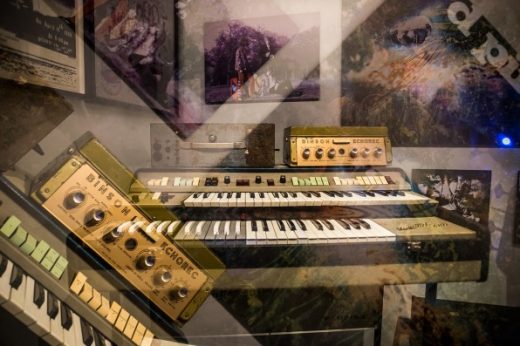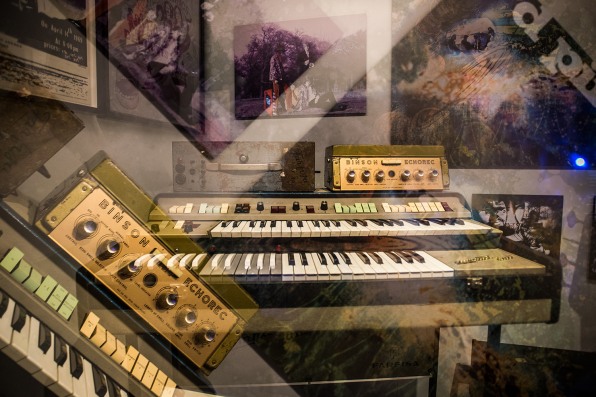A New Pink Floyd Exhibit Celebrates 50 Years Of Music At The Edge Of Tech
Following retrospectives on the Rolling Stones in 2015 and David Bowie in 2013, London’s esteemed Victoria and Albert Museum is now hosting “The Pink Floyd Exhibition: Their Mortal Remains.” Opening May 13, the show spans the British psychedelic-prog-rock band’s entire career, beginning in London’s underground music venues in the late 1960s and snaking all the way to their last performance at Live 8 in 2005. The exhibit is an intricately curated gift to fans, packed with video interviews, live recordings, and treasures from the members’ own archives. But as much as it celebrates the past, it also embraces the future.
“Their Mortal Remains” is an overview of 50 years of music at the bleeding edge of technology. When Pink Floyd started out, the concept of recording music in stereo was a relatively new idea. Some of the first attempts took place at Abbey Road Studios a few decades before Pink Floyd first laid down tracks there in 1967. (That same year, the Beatles recorded Sgt. Pepper’s Lonely Hearts Club Band in mono, which they preferred.) From the original Abbey Road recording console sitting in the lobby of the V&A museum to the immersive 3D audio that fills the exhibit’s final room, “Their Mortal Remains” spans quite a bit of music tech history.
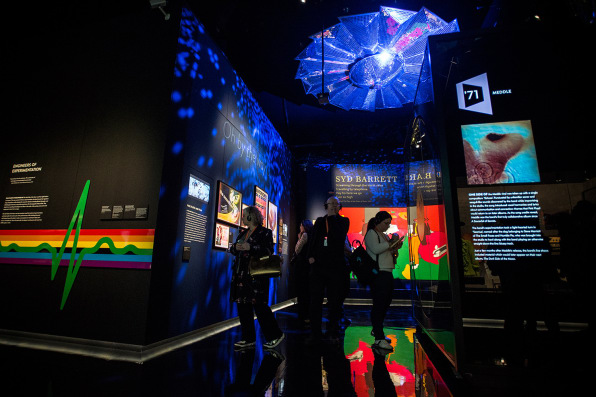
The exhibit is organized chronologically. The first room is lined with psychedelic posters, underground newspaper clippings, and video projections, all of which perfectly capture the spirit of 1967, when Pink Floyd released its first album, The Piper at the Gates of Dawn. Each subsequent room is filled with artwork, instruments, recording gear, handwritten lyrics, never-before-seen live footage, and architectural sketches that collectively illustrate the band’s history.
Explanatory text printed on the wall guides your visit through the galleries—as does, of course, music. A soundtrack of well-known songs, live tracks, and interview clips plays through Sennheiser headphones. As you walk through the rooms, the audio goes with you, cueing up the right tracks no matter how circuitous your route (it’s all thanks to short-field radio frequency technology controlled by overhead sensors and a gadget you wear around your neck). Bored by the band’s middle period? Just keep walking. The whole experience is a bit like strolling through a documentary film that has come to life—with your feet as the fast-forward and rewind buttons.
Pink Floyd was known for using technology to its fullest, pushing the limits of studios and gear. “Their Mortal Remains” captures this deftly, showcasing recording equipment used for experimental tape loops and other audio tricks; vintage electronic synthesizers; and many of lead guitarist David Gilmour’s effects pedals. Today, such pedals are a staple for any guitarist, but in the early 1970s, Gilmour’s layered guitar tone and sound-bending were rare in popular music—one of several Pink Floyd innovations that have since been widely mimicked. Gadgets like Roger Waters’s Binson Echorec 2, known among music gear heads for the echo it added to his bass guitar, is on prominent display throughout the exhibit. Inside one glass case, you’ll find keyboard player Richard Wright’s Minimoog, Prophet-5, and other classic synthesizers rarely seen outside high-priced eBay auctions. The exhibit also includes the band’s custom-built quadrophonic speaker system, which was used to push the sonic limits of their live performances.

“Their Mortal Remains” is lighter on interactive elements than you might expect from an exhibit as proudly tech-focused as this one. In one gallery, visitors can play with the song “Money” from 1972’s Dark Side of the Moon using miniature recording mixers, sliding the volume of vocal tracks and instruments up and down to create their own version of the track. More hands-on elements like this—working replicas of vintage sound machines, for instance, or interactive video displays—would be welcome.
In the final room, a psychedelic video of the band performing the 1979 song “Comfortably Numb” at Live 8 in 2005 is enhanced with 3D audio in Sennheiser’s 9.1 channel Ambeo format. The Ambeo mix, which is required to achieve the format’s three-dimensional, surround-sound-esque effect, was created in collaboration with Sennheiser and Pink Floyd recording engineer Andy Jackson at Abbey Road Studios.
“With Ambeo, we try to create situations where there’s no difference between being there or not. If you close your eyes, your perception tells you its real,” says Daniel Sennheiser, who co-runs the German speaker and audio company with his brother Andreas. Participating in the exhibition, Sennheiser says, was a natural progression; Pink Floyd, the Beatles, and other bands used microphones manufactured by Sennheiser subsidiary Neumann at Abbey Road. A few can be seen among the vintage audio gear included in the exhibit.
The finished mix of “Comfortably Numb”—with 17 channels of audio, compared to just two channels on a standard stereo mix—is piped into the final room through 25 speakers, creating a near-perfect approximation of live music. If it’s recorded—or in this case, remixed—in an Ambeo-friendly fashion, a song can fill a much wider soundstage than stereo or traditional surround sound, with each instrument and track layer standing out in much finer detail than had previously been possible. Like Dolby’s Atmos standard and the DTS:X sound technology, Ambeo promises to push audio a step beyond the traditional 5.1 surround sound format.
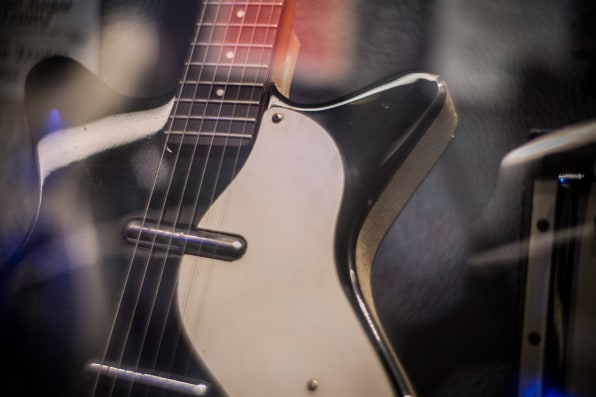
“You can do something which you can do in reality, which is to zoom into one instrument rather than the other. Your brain can do that. You can’t do that on a stereo file. But you can do it in an immersive format,” Sennheiser says.
This type of audio is frequently paired with virtual and augmented reality experiences, an area of growing interest in the music industry. But “Their Mortal Remains”—like the Rolling Stones and David Bowie exhibits—offers a glimpse into how the technology might be used outside of still-maturing VR platforms. “I think it is how we will consume audio in the future,” Sennheiser says.
Maybe, maybe not, but judging by the slack-jawed, sometimes tearful responses from people who attended the Pink Floyd preview this week, this likely isn’t the last we hear of 3D audio.
“Pink Floyd: Their Mortal Remains” opens at the Victoria and Albert Museum on May 13 and runs through October 2017. It is expected to tour other cities.
“Pink Floyd: Their Mortal Remains,” at London’s Victoria and Albert Museum is an immersive journey through the band’s 50 years of musical innovation.
Following retrospectives on the Rolling Stones in 2015 and David Bowie in 2013, London’s esteemed Victoria and Albert Museum is now hosting “The Pink Floyd Exhibition: Their Mortal Remains.” Opening May 13, the show spans the British psychedelic-prog-rock band’s entire career, beginning in London’s underground music venues in the late 1960s and snaking all the way to their last performance at Live 8 in 2005. The exhibit is an intricately curated gift to fans, packed with video interviews, live recordings, and treasures from the members’ own archives. But as much as it celebrates the past, it also embraces the future.
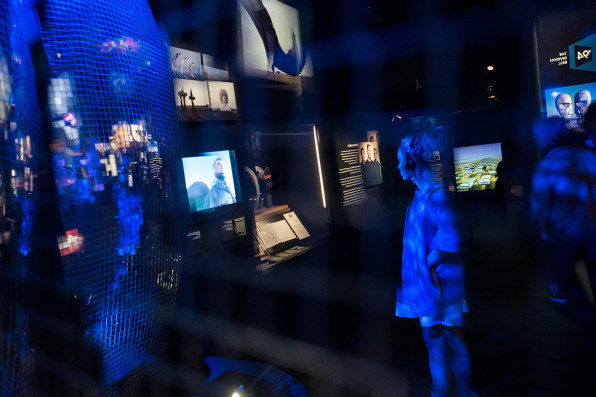
Inside “Their Mortal Remains” at London’s V&A. [Photos: John Paul Titlow]
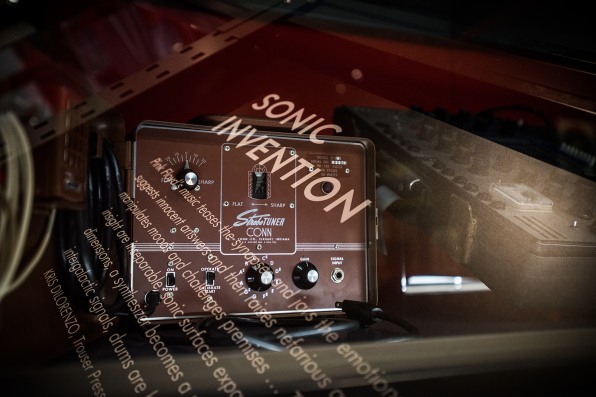
The exhibit highlights Pink Floyd’s sonic experimentation. [Photos: John Paul Titlow]

One of Richard Wright’s vintage synthesizers. [Photos: John Paul Titlow]

An organ and echo effect box. [Photos: John Paul Titlow]
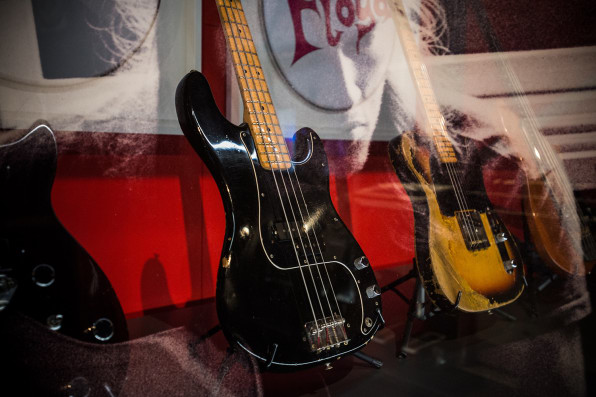
Guitars from the band’s collection. [Photos: John Paul Titlow]
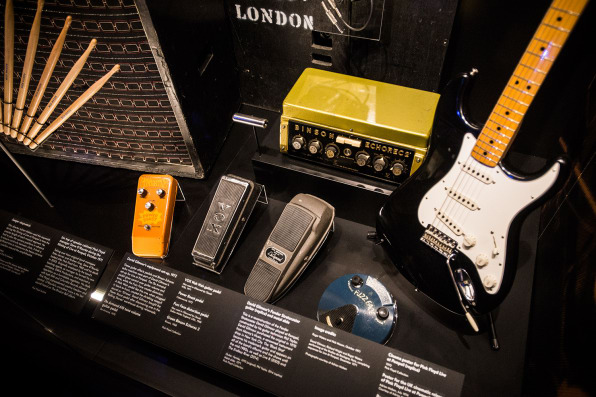
Some of David Gilmour’s guitar effects pedals. [Photos: John Paul Titlow]

Artifacts from the 1972 “Dark Side of the Moon” era. [Photos: John Paul Titlow]
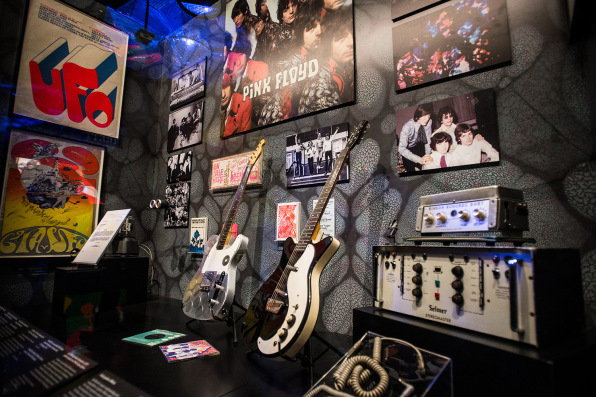
Guitars, effects pedals, and artwork from Pink Floyd’s early period. [Photos: John Paul Titlow]
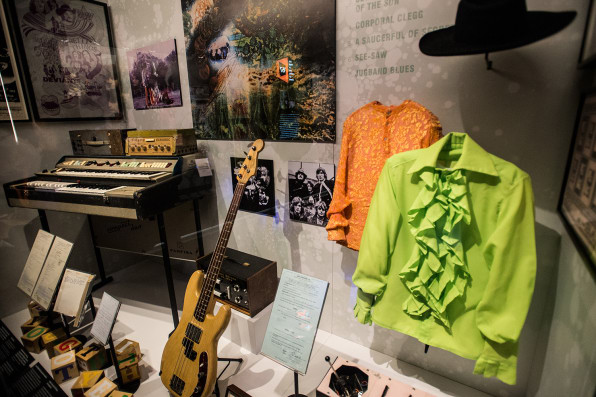
Art, instruments, and fashion from the early days. [Photos: John Paul Titlow]
Fast Company , Read Full Story
(87)

